No, I didn’t get to Hong Kong, but like so many protests around the world, it also came to London, with a little help from the National Campaign against Fees and Cuts, who organised the protest at the Chinese Embassy on 10th October.
It was the last of four stories I covered that day (and I found time to do a few urban panoramas too – which you can see with the other stories on My London Diary) and in some respects the most interesting. But it was probably well after midnight by the time I had finished uploading the earlier stories and was working on the post processing of the final event. Which is perhaps why one of the pictures I uploaded was just a little strange:

As is probably obvious, this suffers from a rather nasty case of extreme distortion, though perhaps that makes the yellow and black umbrella stand out even more.Here’s the image that I intended to post:
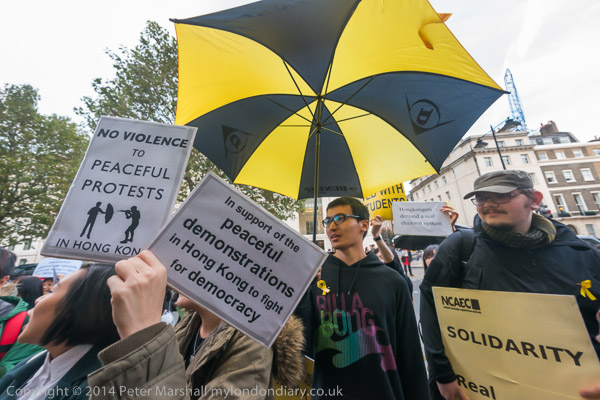
D700, 16mm fisheye, ISO 800, 1/80 f5.6
It still looks a little distorted, and the verticals are converging, though that isn’t necessarily a bad thing.
I’d made the original picture from which both these were derived using the Nikon 16mm fisheye, chosen mainly because I was in a very crowded situation on the pavement in front of the Chinese embassy and unable to move any further back from the subject. I’d wanted both the umbrella and the messages on the poster, with the ‘No Violence to Peaceful Protests in Hong Kong’ at the left- with another umbrella and, at the right the word ‘Solidarity‘. The text on placards is very important when photographing protests (something I learnt rapidly from the first editor I took my pictures to), and something you always need to be aware of in all images, as legible text always alters the way that we see images.
I usually process the images from the 16mm using either the Fisheye-Hemi plugin, PtGui or occasionally Photoshop’s ‘Adaptive Wide Angle’ filter. The first two are rather simpler to use and more or less automatically convert from fisheye to a cylindrical perspective, straightening the verticals and reducing the curvature of objects at the edges of the frame. Fisheye-Hemi has just 3 options, depending on the type of fisheye lens you have used (circular, full frame or partial), while PtGui gives greater flexibility. Photoshop’s own filter enables you to straighten any of the lines curved by the lens, but to do a great deal of work usually involves losing a lot of the image, and I usually end up getting some very funny curves indeed and deleting the results.
Somehow I have used Fisheye-Hemi twice on the top image, not a good idea. While the edges oft he placards and the crane at right are more or less straight in the lower picture, they have become curved in the opposite sense to the original in the upper image in a kind of extreme pin-cushion distortion.
Another pair of images perhaps gives a clearer view of what Fisheye-hemi does:
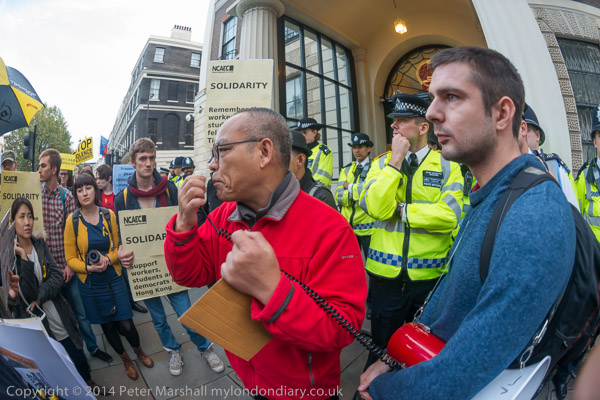
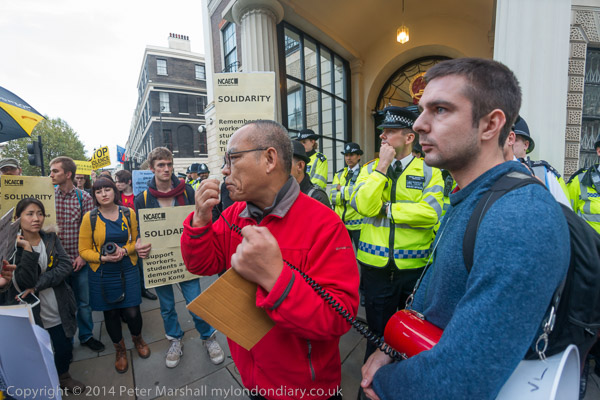
D700, 16mm fisheye, ISO800, 1/60 f5
The protesters were crowded around the doorway of the Chinese embassy – much to the annoyance of the police, who like to keep protests to the opposite side of the road. I am very close to the speaker and the man at right who I could reach out and touch. In the upper images there is very clear curvature close to the edges, particularly noticeable in the pillar of the doorway at the extreme right of the image, but also in the other building in the background and in the woman at the left of the frame.
Fisheye-Hemi has more or less straightened the verticals of the architecture and made that woman look fairly normal. You can also see that the centre points of all four sides show identical subject matter – at left the word ‘Solidarity’, at top centre the top of the pillar, at right a police officer’s ear and at bottom centre the lower edge of that red jumper (I’ve cropped the lower image very marginally to remove a little distraction, which is why there is very slight less of that officer’s face.)
There is also a little part of the image missing at the corners, something you need to be aware of when taking pictures, but it isn’t really a great deal. Because you keep those four edge centres the viewfinder image remains a pretty goo way to frame the image.
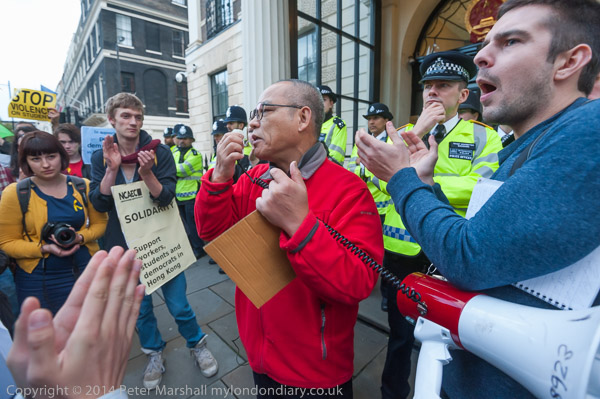
D700, 16mm fisheye, ISO 2500, 1/160 f5
Here’s another image taken a few minutes later when people were applauding. I’m pretty sure my shoulders were touching those of the guy whose hands appear at the left of the image.
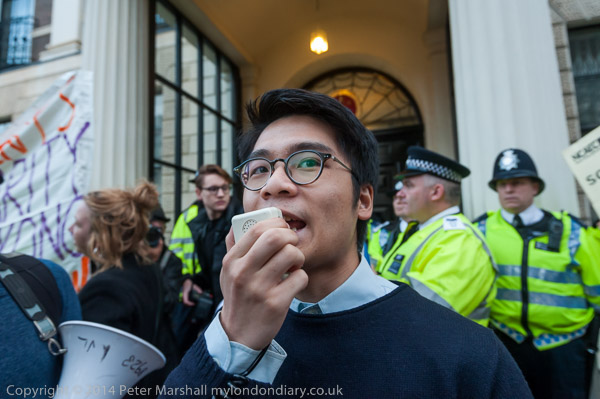
D700, 16-35mm at 22mm ISO 2500 1/160 f5
Here’s another picture of a different speaker taken from more or less the same position but with a different lens. It’s an ultra-wide view, with the 16-35mm at 22mm, which gives a good idea of how close I really was to the speakers – and I couldn’t move back because of the crowd.
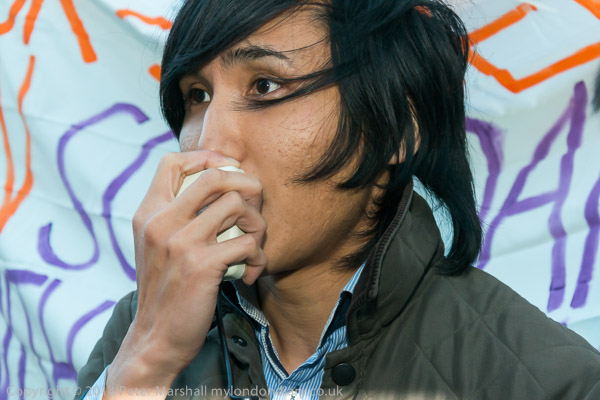
D800E, Nikon 18-105mm DX, 62mm (93mm equiv) ISO 1000, 1/60 f7.1
Later I moved a little to the side and was able to work with a longer lens. I could even work from a distance where I could use a more normal ‘portrait’ focal length, in this case 93mm equivalent using the 18 – 105mm. By this time the light was getting low and I was needing flash to brighten up the ambient.
More pictures from the event at Solidarity with the Umbrella Revolution.
______________________________________________________
My London Diary : Buildings of London : River Lea/Lee Valley : London’s Industrial Heritage
All photographs on this and my other sites, unless otherwise stated, are taken by and copyright of Peter Marshall, and are available for reproduction or can be bought as prints.
To order prints or reproduce images
________________________________________________________